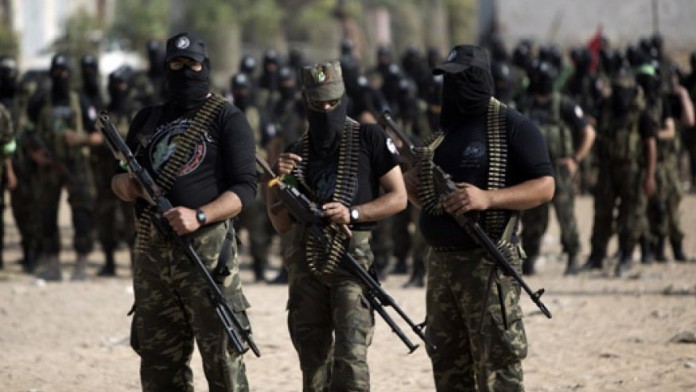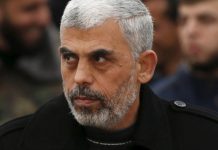
Pentagon leaders indicated Monday that the United States could carry out more operations targeting Islamic State figures, aided by video and other information gathered during the raid in Syria that led to the death of Islamic State leader Abu Bakr al-Baghdadi.
Officials said two men were captured during the weekend raid who could provide intelligence about the group. Baghdadi’s remains, which were tested to confirm his identity, were buried at sea within 24 hours of his death in accordance with Muslim custom, one official said.
The new details emerged as Trump administration officials sought to place the operation in the context of an overall strategy to bring peace to Syria while ending the terrorism threat in the region.
“There is a logic to this,” a senior State Department official said, even though “sometimes it may not seem clear to everybody.”
In addition to the military attacks, “what we’re trying to do diplomatically and politically in the region . . . basically is part of a fairly well-thought-out effort to deal with the underlying causes” of the Islamic State’s rise, the official said, speaking to reporters under conditions of anonymity set by the administration.
Baghdadi’s death has “everything” to do with that goal, the official said. “If the international community does not deal with the feelings of oppression” among many Syrians under the government of President Bashar Assad, “they turn to others who will give them easy answers,” including militant leaders like Baghdadi.
But the U.S. strategy has often been overwhelmed by President Donald Trump’s public approach to the Syria crisis. On Sunday, Trump described the live-stream video of the raid in graphic terms akin to an action movie, saying Baghdadi “died like a coward . . . whimpering and crying and screaming all the way.”
In a speech to police chiefs Monday, he erroneously spoke of “tens of thousands” of captured Islamic State fighters, actually believed to number about 10,000. Trump said the militant movement – whose territory in Iraq and Syria had been cut at least in half by the U.S. military and its local allies by the end of 2016 – was growing “big, big, big” until he became president.
Summing up the second reversal of his twice-announced withdrawal of all U.S. troops in Syria, Trump said that “we don’t want to be the policeman” there but that “we are keeping the oil.”
Trump has suggested that, in addition to keeping the oil – in a desert region in far-eastern Syria, U.S. energy companies could exploit it. The United States, he said Sunday, “should be able to take some.”
Pentagon and State Department officials provided a more layered explanation, saying the oil will continue to be sold by the Syrian Democratic Forces – the Kurdish-dominated U.S. allies who routed the Islamic State – to pay for the administration of territory now under SDF control, as well as “their ability to secure ISIS prison camps and conduct operations against ISIS,” Defense Secretary Mark Esper told reporters at the Pentagon. ISIS is another name for the Islamic State.
The U.S. mission will also include ensuring that the Syrian regime and its ally Russia do not gain access to the energy resources.
“That’s our mission,” Esper said, “to secure the oil fields.”
In one of the many ironies of Syria’s complicated battlefield, the SDF sells most of the oil to Assad’s government, which in the past received much of its energy supplies from Iran, which is now under U.S. export sanctions.
One U.S. official, speaking on the condition of anonymity to address internal discussions, said the Pentagon had not finalized plans for the mission in the oil region of Deir al-Zour province. A U.S. official familiar with the plans said they almost certainly include Bradley Fighting vehicles along with, potentially, hundreds of troops, in addition to about 200 already there.
At the Pentagon, Esper and Army Gen. Mark Milley, chairman of the Joint Chiefs of Staff, declined to provide a total figure but said there would be fewer troops overall in Syria than the approximately 1,000 there before Trump made his withdrawal announcement earlier this month. The announcement came after Trump yielded to a Turkish invasion into northeastern Syria to drive out the Kurdish force, which Turkey considers a terrorist group, at least 20 miles south of the border.
The oil protection mission may draw new scrutiny from lawmakers who want to make sure U.S. military operations do not expand beyond the scope of congressional authorizations. The long-standing Authorization for Use of Military Force used for U.S. counterterrorism operations, allowing the military to prevent “future acts of international terrorism,” was written to apply to those responsible for the 9/11 terrorism attacks. But successive administrations have applied the law more generally to military counterterrorism activities.
Even as it recommits to the counter-Islamic State mission, the administration is trying to get other countries to contribute more on the ground. It plans to host a meeting of foreign ministers from about three dozen countries that are part of the international coalition against the militants on Nov. 14 in Washington, in an effort to persuade them to contribute more money and troops to patrol a buffer zone separating Turkey and the SDF.
So far, despite high-level U.S. appeals, no country has offered to participate in such a force.
Among other details about the raid that became known Monday, a U.S. official with knowledge of the operation, but without authorization to speak on the record, confirmed that Baghdadi’s remains were buried at sea within 24 hours, in accordance with Muslim custom.
Baghdadi detonated a suicide vest while running in a dead-end cave from U.S. forces, Trump said Sunday as he announced the terrorist leader’s death. Esper said that fewer than 100 U.S. troops were involved in the operation on the ground. Other U.S. officials said it was carried out by elite members of Delta Force and the 75th Ranger Regiment.
The raid, launched from Iraq, was carried out near the town of Barisha, in Syria’s northwestern Idlib province, about four miles from the Turkish border. The Special Operations troops spent about two hours on the ground.
“We couldn’t have done any of this without partners and allies to provide intelligence, to provide places to stage our forces, to provide overflight and deconfliction, and even some of our foes, such as Russia, we had to deal with in order to do this,” the State Department official said.
Russia, informed of the operation in what officials said were vague terms, agreed to open airspace under its control to the eight helicopters that participated in the operation.
This official and others praised the SDF for supplying key intelligence. “It’s a very, very important role,” the official said. “Nobody should underestimate how key the SDF was in all of this.”
Speaking of Baghdadi’s “demise over the weekend,” the official said that a second high-level Islamic State official, Abu Hassan al-Muhajir, was killed over the weekend near the northern town of Jarabulus, in Aleppo province, “also by U.S. forces.”
No details were provided, and the Defense Department declined to comment.
The Kurdish-dominated SDF appears eager to demonstrate its ongoing value and maintain strong ties to the U.S. military. In tweets Monday, a senior official in the organization, Polat Can, said that “our own source” had provided information on Baghdadi’s whereabouts and movements, and provided DNA proof of his identity before the raid was launched.
A similar claim was made by Gen. Mazloum Kobane Abdi, the SDF commander, in an interview with NBC News.
(c) 2019, The Washington Post · Dan Lamothe, Karen DeYoung
{Matzav.com}











